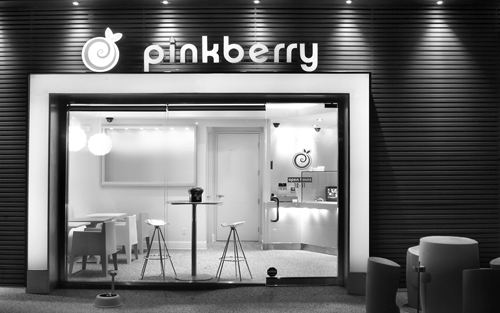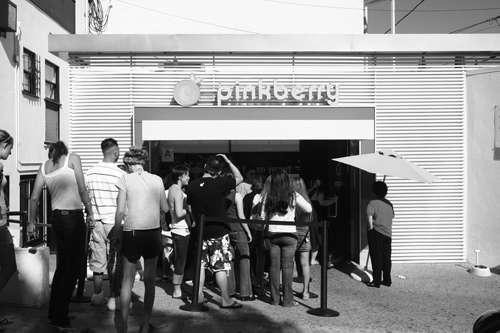How They Started (26 page)
Authors: David Lester

Jamba Juice went public in 2006 using a somewhat unconventional method: the company was acquired for $265 million by a publicly traded “blank check” acquisition company, Services Acquisition Corp. International, which was created expressly to buy up companies. SAC then changed its name to Jamba Inc. The maneuver allowed Jamba to skip the grueling investor “road show” that usually precedes an IPO and avoid making detailed financial disclosures.
Where are they now?
Flush with new cash from the IPO deal, Jamba grew quickly to over 730 units by 2008 and nearly $334 million in sales. But there was trouble brewing: Jamba racked up losses each year, hitting a high of nearly $150 million in 2008, just in time to confront a major economic recession.
Jamba was in a poor position to withstand the downturn on the heels of its rapid growth and losses. CEO Clayton resigned and Safeway executive James White was named as Clayton’s replacement in late 2008.
The company’s policy of owning most of its stores had come back to bite it, causing revenue to plummet, along with the company’s stock price. A re-franchising initiative found franchise buyers for more than 140 company stores, which generated franchise fees and cut the number of company-owned units. Revenue fell to $255 million in 2010, but losses also fell, shrinking to under $21 million.
Turnaround efforts have focused on repositioning Jamba as a health and fitness brand with food for all three meals of the day. Hot beverages were introduced in stores for the cold months to shore up winter revenue. White also cut deals to license the Jamba name to grocery-goods makers to bring Jamba products, including smoothie mixes and fruit chips, to grocery shelves.
By year-end 2010, comparable-store sales had stabilized. The company returned to profitability in mid-2011.
One bright spot in Jamba’s recent struggles is that one founding employee returned to the fold. In 2009, Linda returned and, with her husband, bought and still operates nine Jamba franchise stores in California, including the original store.

Creating a swirl in the market
Founders:
Hyekyung “Shelly” Hwang and Young Lee
Age of founders:
31 and 39
Background:
Restaurant manager and architect
Founded in:
2004
Headquarters:
Los Angeles, California
Business type:
Frozen yogurt shops
After the turn of the 21st century,
frozen yogurt was a fading American fad. By 2005, the volume of frozen treats produced in the US had fallen by half compared with 1990, the International Dairy Foods Association reported.
Then along came two entrepreneurs from South Korea, former restaurant manager Shelly Hwang and architect Young Lee. They had a new twist on frozen yogurt that would win them wildly enthusiastic fans and help reinvent the category to suit modern tastes. But that triumph came only after the pair faced down problems including irate neighbors, unhelpful relatives and nasty lawsuits.
Shelly came to the US in 1992 to study business at the University of Southern California. After she graduated, Shelly’s father put her in charge of an LA franchise restaurant he owned with some business partners. Then just 26, Shelly soon realized she was in over her head.
The full-service restaurant had many different menus—steaks, pastas, desserts, a buffet. Shelly tinkered with the offerings, but customers were still confused. Was it a steak house? A pasta bar? Sales were only about $500 a day, she recalls. She lasted two years before the restaurant closed down.
“I kept increasing the menu, instead of specializing it,” Shelly recalls. “I lost a lot of money—not my money, but our money. And after that, my father stopped supporting me.”
Shelly next started a textile business, an enterprise that ultimately failed as well. She made many trips abroad while learning the business, especially to Italy. It was there, on a visit to the affluent northern Italian town of Reggio Emilia, that she says she encountered tiny, mom-and-pop frozen yogurt shops.
The yogurt they sold wasn’t like sweet, heavy American yogurt—it was non fat, tart and often topped simply with fresh fruit. She learned that some of these small, utilitarian shops had been operating for 25 years or more. They were successful businesses on a small scale, Shelly saw, but the owners didn’t have the vision to build a chain.
Intrigued, Shelly tracked down the local shops’ Italian yogurt manufacturer and brought samples back to the USA to test. She missed the restaurant business and still dreamed of opening her own restaurant.
“I didn’t have a research-and-development person,” she recalls. “I had a tiny office, one machine, and I’d just drop in the yogurt and milk and taste it and throw it out, again and again and again.”
Meanwhile, Shelly thought she would try a time-tested dining concept first, to give her a more assured success. She laid plans to open an English-style teahouse.
Scouting locations, she located a funky, 650-square-foot West Hollywood storefront on Huntley Drive, just south of main thoroughfare Santa Monica Boulevard. The storefront was a converted two-car garage that had formerly served as a tattoo parlor. The store was set back from the street, which Shelly thought would help create a relaxing, secluded feel for the teahouse.
Shelly signed a lease for the space, a move she would soon regret. Her application for the teahouse’s liquor license was opposed by local residents. The store’s neighbors turned out in force at numerous public hearings to voice their objections. They didn’t want their quiet street disrupted by loud drunks. The process dragged on for nearly a year before her application was denied.

The original store in West Hollywood.
By now, Shelly had experimented with her yogurt recipe until she hit on a formula she liked. Already under lease for the West Hollywood store, she decided to go to Plan B: she would open a frozen yogurt shop. This would not require a liquor license, so she would be free to open the doors as soon as the shop interior was built.
“I didn’t have a research-and-development person. I had a tiny office, one machine, and I’d just drop in the yogurt and milk and taste it and throw it out, again and again and again.”
Shelly was excited by the prospect of moving forward to open her own eatery. But her father, who had since returned to South Korea, didn’t think much of her idea.
“My father didn’t call me for a year,” she says. “‘You are embarrassing to my family members,’ he said. ‘You are going to be sitting behind the counter, reading a magazine and selling a couple yogurts. Do not call me anymore!’”
Mindful of her previous restaurant failure, Shelly envisioned a simple menu for her yogurt store. Initially, there would be just two flavors, “original” or plain, and green tea. There was also shaved ice with flavored syrup, as an alternative for the lactose intolerant. The store wouldn’t even sell bottles of water to go with the yogurt—just a variety of toppings, mostly fresh fruit. The yogurt came in four sizes, from extra-small to large.
With the menu in place, Shelly sought a designer. She wanted an eye-catching, memorable look that imparted a refreshing, restful feeling. She interviewed several architects before choosing Young, whom she knew by reputation.
Young told her the Huntley Drive site was the worst retail location he’d ever seen. Parking was scarce, the store was hardly visible due to its setback, and the tiny store was off the main drag for pedestrians. But Shelly told Young he had to figure out a design for the existing store.
Shelly sought a designer. She wanted an eye-catching, memorable look that imparted a refreshing, restful feeling.
Together, they brainstormed a name for the concept. Shelly says they came up with Pinkberry “because pink is a very positive color, and the word had a nice rhyme to it. We wanted people to picture fresh, happy berries.”
While the big yogurt chains of the 1980s had a cheap, fast-food feel, Young created a sleek, “fun,” high-style look for Pinkberry. The décor featured lots of white, with sherbet-colored dots of pink, orange and green for accents.
Young selected top-drawer, name-designer furnishings: sleek, translucent Philippe Starck Victoria Ghost chairs; Le Klint light fixtures that evoked a ball of swirled yogurt; white, oval Isamu Noguchi tables; and minimalist wood-strip Case Study benches. A pebbly floor evoked the beach and summertime. The company logo was a simple pink swirl topped with a fruit leaf. The feeling he was going for, Young said later, was not unlike the makeup counter at Bloomingdale’s—warm, flattering lighting and an environment that makes customers feel special.
Pinkberry opened on January 10, 2005, staffed by Shelly and one part-time employee hired through a classified ad. Midwinter wasn’t the best time to open a frozen-treat shop, but Shelly didn’t want to wait.
When she put out the “Open” sign, a couple from the neighborhood came in—not to buy, but to offer their condolences. They told her bluntly that a yogurt shop was not going to make it in this odd locale. Then they bought a cup of yogurt, just because they felt bad for her.
For the month of January, total sales were $70. “I was really depressed,” Shelly recalls. “I thought, I’ve got this home equity loan from the bank and if I lose this business, I’ll lose my house, and I’ll have to go back to Korea and beg my parents to live with them.”
Confident that she could get customers by handing out free samples, Shelly loaded a cooler with yogurt and began walking up and down the street. But few pedestrians were willing to accept her free samples. She literally couldn’t give the yogurt away.
They told her bluntly that a yogurt shop was not going to make it in this odd locale. Then they bought a cup of yogurt … they felt bad for her.
The only hopeful sign: the neighbors who were her first customers returned to buy more yogurt. When she asked why, Shelly recalls they said, “You know, I keep thinking about it. After dinner, I want to have it.”
The low-calorie, non-fat, yogurt was a perfect fit for the capital of compulsive dieting. Diners felt good about treating themselves to Pinkberry regularly—in some cases three or more times a week. Where many dessert shops saw more occasional business, Pinkberry quickly developed a stable of regulars. There was no advertising campaign whatsoever, but word of mouth began to bring a slow trickle of customers in the door, despite the fact that it was a particularly nasty California winter with lots of rain.

Hordes of people would queue up for their “fix” of Pinkberry yogurt.
One rainy night, Shelly and Young—who had become romantic partners as well as business partners—were dining out when they got a call that the store’s roof was leaking. They drove to Pinkberry to find the windows fogged from moisture. It was hard to see what was going on inside. When they opened the door, they found the small eatery packed with patrons. Shelly and Young started to feel more hopeful. They forgot all about the roof leak.